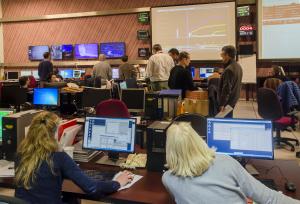Out WEST
A purple haze on the screens
26 Feb 2018
-
R.A.
Numbers, graphs and a wobbling purple haze on the monitoring screens—this is what a plasma shot looks like when seen from the control room of the WEST tokamak.
By the end of this year, WEST's plasma heating system should be fully operational. For the moment, only two lower hybrid antennas and one ion cyclotron resonance heating antenna (out of three) are installed.
Since its first plasma in December 2016, the former Tore Supra tokamak has logged some 2,500 shots. Upgraded, transformed, equipped with an actively cooled tungsten divertor, and graced with a new name—WEST (Tungsten (W) Environment in Steady-State Tokamak)—the machine is being groomed to act as a test bed for ITER, minimizing industrial and financial risks and obtaining experimental data to prepare for operation.
On 16 February, WEST shot the last plasmas of a campaign that had begun one month earlier with the coupling of the machine's two lower hybrid antennas. By the end of this year, the plasma heating system, including three ion cyclotron resonance heating antennas procured by China, should be fully operational.
WEST is now well advanced on the way to becoming an "ITER-like" machine. Out of the 456 actively cooled plasma-facing units in tungsten that make up the divertor, six (three procured by Japan and three by China) are already in place and six more (procured by Europe) will be installed in the coming months. The full actively cooled tungsten divertor configuration should be ready for operation at the end of 2019.
In the meantime, operators in the control room are "learning to drive." Although several features from the "old" Tore Supra have been preserved, WEST is definitely a new machine with a different magnetic configuration (extra coils have been installed under the divertor) that allows for the production of ITER-like D-shaped plasmas.
Jérôme Bucalossi (right) is confident that by the time the tungsten divertor is complete, WEST will have reached the high confinement mode that will be ITER's operational regime.
Over the past few months, the WEST team has been busy fine-tuning the coils, adjusting the position and power of the first lower hybrid antenna, and monitoring the behaviour of the plasma-facing components. Jérôme Bucalossi, who heads the WEST project at CEA's Institut de Recherche sur la Fusion Magnétique (IRFM), is confident that by the time the tungsten divertor is complete, WEST will have reached the high confinement mode ("H mode") that will be ITER's operational regime.
Although almost routine by now (WEST produces an average of 30 pulses per operating day) the pulsating haze on the screens makes a fascinating sight—deuterium nuclei spinning madly for a few seconds inside a magnetic cage. Not quite fusion yet ... but a foretaste in anticipation of the real thing.
Click here to view a video of a plasma shot in WEST.



